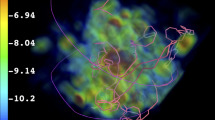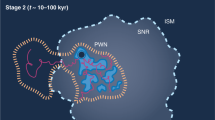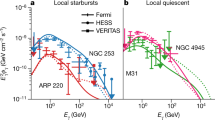Abstract
LAST year saw the birth of observational gamma-ray astronomy with the detection of cosmic gamma-rays with energies above 100 MeV energy by Clark et al.1. Their results indicated that cosmic gamma-radiation is strongly anisotropic, being most intense in the galactic plane and particularly at the galactic centre. There seems to be a background component of isotropic gamma-radiation possibly of extragalactic origin (which I have already discussed in ref. 2) having a magnitude of ∼ 1×10−4 cm−2 s−1 sr−1 Superimposed on this background there seems to be a component from the galactic disk, having a line intensity of 1–2 × 10−4 cm−2 s−1 rad−1. Gamma-rays coming from the region of the galactic centre have a line intensity of 4–5 × 10−4 cm−2 s−1 rad−1. Clark et al.1 suggested that these fluxes, being an order of magnitude higher than those predicted from various diffuse production mechanisms, may originate mainly in unresolved discrete sources (a suggestion which was further explored by Ögelmann3). They were careful to point out, however, that large amounts of undetected hydrogen may also account for these fluxes.
This is a preview of subscription content, access via your institution
Access options
Subscribe to this journal
Receive 51 print issues and online access
$199.00 per year
only $3.90 per issue
Buy this article
- Purchase on SpringerLink
- Instant access to full article PDF
Prices may be subject to local taxes which are calculated during checkout
Similar content being viewed by others
References
Clark, G. W., Garmire, G. P., and Kraushaar, W. L., Astrophys. J. Lett., 153, L203 (1968).
Stecker, F. W., Nature, 220, 675 (1968).
Ögelmann, H., Nature, 221, 753 (1969).
Shen, C. S., Phys. Rev. Lett., 22, 568 (1969).
Cowsik, R., and Pal, Y., Phys. Rev. Lett., 22, 550 (1969).
Shivanandan, K., Houck, J. R., and Harwit, M. O., Phys. Rev. Lett., 21, 1460 (1968).
Gould, R. J., and Salpeter, E. E., Astrophys. J., 138, 393 (1963).
Gould, R. J., Gold, T., and Salpeter, E. E., Astrophys. J., 138, 408 (1963).
Von Dorschner, J., Gürtler, J., and Schmidt, K. H., Astron. Nachr., 288, 149 (1965).
Mebold, U., Beit. z. Radioastron., 1, 97 (1969).
Werner, M. W., and Harwit, M., Astrophys. J., 154, 881 (1968).
Author information
Authors and Affiliations
Rights and permissions
About this article
Cite this article
STECKER, F. Origin of Galactic Gamma-rays. Nature 222, 865 (1969). https://doi.org/10.1038/222865a0
Received:
Issue date:
DOI: https://doi.org/10.1038/222865a0
This article is cited by
-
Propagation of cosmic rays in the galaxy
Space Science Reviews (1975)
-
Diffuse Cosmic Gamma rays: Present Status of Theory and Observations
Nature Physical Science (1973)
-
An estimate of the energy spectrum of gamma rays from the central region of the Galaxy and some implications
Astrophysics and Space Science (1972)
-
Isotropy of Cosmic γ-Ray Flux between 1 and 6 MeV and Implications for Future Investigations
Nature Physical Science (1971)
-
High-energy Gamma-ray Astronomy
Nature (1970)



